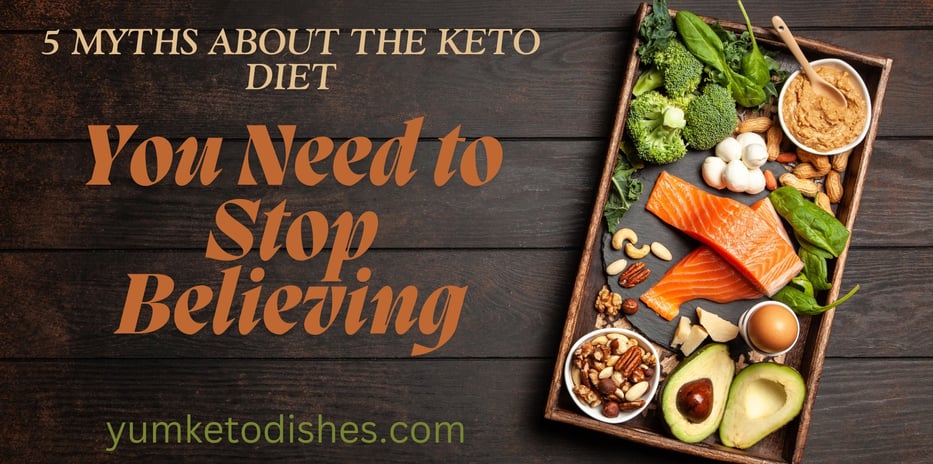5 Myths About the Keto Diet You Need to Stop Believing
The ketogenic (keto) diet gained popularity during the previous decade because people celebrate its ability to burn fat while managing blood sugar along with enhancing mental clarity. Mainstream popularity of any new diet typically creates a wave of false information that catches fire among followers. Many people who investigate keto or have attempted it find themselves puzzled by several widespread myths that need proper explanation. We need to address five prominent errors that people have about the keto diet plan.


Introduction
The ketogenic (keto) diet achieved widespread popularity across the previous decade because it shows promise for burning fat while maintaining stable blood sugar together with improved cognitive performance. Any diet that gets popular with the mainstream public has led to extensive misinformation spreading rapidly. People who are interested in the keto diet or have used it with doubtful results probably came across several enduring misconceptions that need correction. Five fundamental keto myths will be addressed in this piece to clarify their misinformation.
If you want to lose weighit , gain energy, improve productivity, feel amazing...In Just 40 Short Days this program Helped 10K+ women lose weight! click here for more
Myth 1: “Keto Causes Muscle Loss”
The Claim : Critics declare that keto diet carbohydrate limits force your body to use muscle tissue for fuel rather than fat.
The Truth : Muscle preservation occurs when people follow the keto diet in the correct manner. Through the ketosis process the body uses fat as its primary energy source rather than working through muscle tissue. One can experience muscle tissue loss when following these procedures:
•Proper protein consumption remains essential during keto because under-eating it will cause negative outcomes.
•The combination of strength training exercises with this diet regimen should be avoided.
•Crash-diet without proper nutrition.
The Fix : You must focus on consuming protein at the rate between 0.6 to 1.0 grams each day for every pound of your body weight while doing resistance training exercises. When you optimize protein intake and exercise levels while following Keto your body will preserve lean muscle mass.
Check this Ultimate Guide to Weight Loss: Proven Diet Plans for a Healthier You, And See The Results Yourself
Myth 2: “Keto Is Bad for Your Heart”
The Claim : High intakes of saturated fats present in butter and red meat along with cheese may trigger artery blockages leading to elevated cholesterol when following the keto diet.
The Truth : The studies about keto effects on heart health produced conflicting results yet the diet fails to negatively impact heart wellness for everyone. For many people, keto:
•The consumption of a ketogenic diet leads to higher levels of HDL cholesterol while reducing triglycerides in the body.
•Heart disease evidence shows that these foods decrease swelling which remains as a primary cause of heart disease.
•Keto consumption helps people control their blood pressure as well as blood sugar levels.
The quality of fats stands as an important factor. You should substitute heart-unfriendly processed meats as well as fried foods with heart-healthy fats including avocado, olive oil and nuts and fatty fish. Check your cholesterol levels regularly with medical supervision if heart diseases affect your personal history.
Myth 3: “You Can’t Exercise on Keto”
The Claim : According to proponents of low-carb diets exercise becomes impossible because their energy-depleting properties cut off workout possibilities.
The Truth : Many athletes succeed with keto after their body adapts to conclude the transition from carbohydrate usage to using fat as fuel. When your body achieves a state of fat adaptation it will use stored fat as a fuel source effectively for endurance activities which can include running, cycling or hiking.
The Caveat : Ketosis creates temporary performance issues for athletes following high-intensity workouts involving sprinting or CrossFit exercises. Athletes who follow targeted keto strategy administer small amounts of carbohydrates before their workouts to achieve optimal performance.
If you want to lose weighit , gain energy, improve productivity, feel amazing...In Just 40 Short Days this program Helped 10K+ women lose weight! click here for more
Myth 4: “Keto Is Just the Atkins Diet Repackaged”
The Claim : The statement that keto shares no differences with the 2000s Atkins diet remains false.
The Truth : Both diets limit carbohydrate intake but they exclude different elements from their protocols.
•Atkins : Atkins begins with an extremely low carbohydrate daily limit (20g) before slowly adding back carbohydrates to the diet.
•Keto : Keto maintains very low carb intake (20–50g/day) indefinitely to sustain ketosis.
•Focus : Protein takes center stage in Atkins but keto centers its calorie structure with around 70–80 percent originating from fat.
Keto is more metabolically focused, aiming to keep your body in fat-burning ketosis long-term.
Check this Ultimate Guide to Weight Loss: Proven Diet Plans for a Healthier You, And See The Results Yourself
Myth 5: “Everyone Gets the Keto Flu”
The Claim : Keto newbies commonly have to endure severe side effects such as headaches together with extreme fatigue and mental confusion when they start their keto journey.
The Truth : Although the "keto flu" occurs frequently it remains possible to prevent its symptoms. The keto flu occurs because electrolyte imbalances between sodium, potassium and magnesium cause dehydration which leads to water weight loss.
The Fix :
• The remedy for keto flu symptoms includes consuming bone broth together with adding salt to your food.
• Eat magnesium-rich foods (spinach, almonds).
• The best way to combat keto flu symptoms includes both hydration maintenance and possible electrolyte supplement use.
Many people sidestep keto flu entirely with proper preparation.
